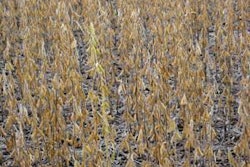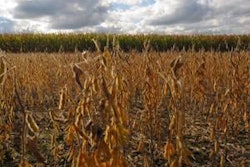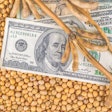The U.S. corn and soybean markets continue to reflect uncertainty about the potential size of the country’s 2013 corn and soybean crops, according to reports. Since mid-June, December 2013 corn futures have traded in an 80 cents range, and November 2013 soybean futures have traded in a $1.00 range as production expectations shifted up and down. Uncertainty about both acreage and yield prospects has contributed to the trading range, according to University of Illinois agricultural economist Darrel Good.
“The [U.S. Department of Agriculture]’s June Acreage Report showed that producers planted, or intended to plant, slightly more acres of both corn and soybeans than indicated in the March Prospective Plantings report,” said Good. “The report also showed that the difference between planted acreage and expected harvested acreage of corn for grain was larger than average at 8.244 million acres. On the other hand, the expected difference between planted and harvested acreage of soybeans was smaller than average at 810,000 acres.”
Given the lateness of the 2013 planting season, reported prevented planted acreage is likely to be large, said Good. In addition, some planted acreage has been lost to flooding. As a result, actual planted and harvested acreage of both corn and soybeans are likely to be less than the June estimates. The magnitude of the difference, however, may remain uncertain until October.
Good said that the same factors that have created uncertainty about planted and harvested acreage of corn and soybeans have also contributed to early-season yield uncertainty. ”Judging from current crop condition ratings, yield prospects at this stage of the growing season are quite good,” he said. “However, overall yield prospects will be influenced less by developments to date and more by weather conditions over the next two months as the crops go through the reproductive and filling stages.
“Recent weather and near-term weather prospects are a bit of a mixed bag with almost ideal moisture conditions in many areas, but too much rainfall in some areas, dryness developing in some western areas, and generally above-average temperatures this week,” said Good. “As usual, there are some differences of opinion about longer-term weather forecasts. Prospects for moderating temperatures and thunderstorm activity, however, bode well for yield prospects. The markets will continue to monitor crop condition ratings for indications of yield potential.”
According to Good, even with harvested acreage less than currently estimated, prospects for corn and soybean yields near trend value in 2013 point to large crops and the likely buildup in stocks during the 2013-2014 marketing year. “Due to the extreme lateness of soybean planting in some western and northern growing areas, soybean yields may be at more risk than corn yields,” he said. “Soybean yield uncertainty could persist later in the season than is normally the case, with new-crop soybean futures reflecting more production risk than new-crop corn futures.”















